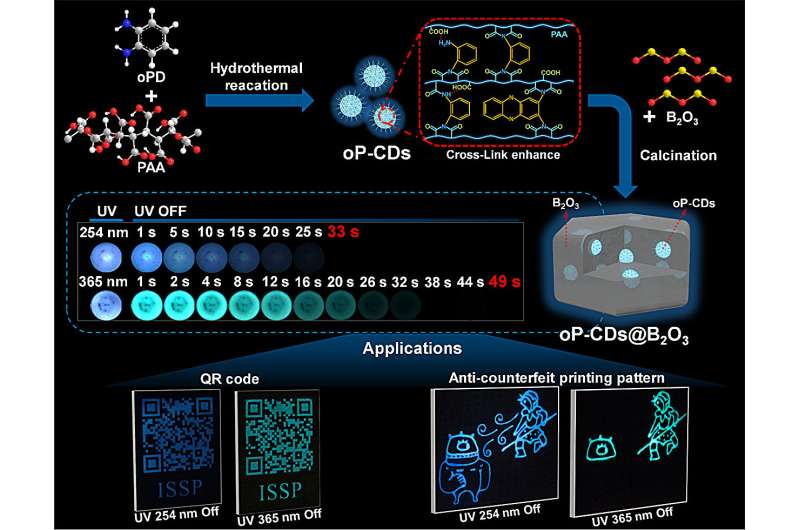This article has been reviewed according to Science X's editorial process and policies. Editors have highlighted the following attributes while ensuring the content's credibility:
fact-checked
peer-reviewed publication
trusted source
proofread
Novel method developed for phosphorescent multi-color carbon dots

A research team has devised a novel method to prepare carbonized polymer nanodots capable of emitting multi-color ultra-long room-temperature phosphorescence (RTP) from blue to green.
"These materials exhibit potential applications in anti-counterfeiting and information encryption," said Zhang Qipeng, member of the team.
The research findings have been published in Advanced Science, and the study was led by Jiang Changlong from Hefei Institutes of Physical Science of Chinese Academy of Sciences
RTP materials glow even after the light source is removed, making them valuable for various uses like security features, data protection, displays, and medical imaging. Carbon dots (CDs) are a kind of RTP material known for being easy to make, stable under light, and safe. But making bright and long-lasting RTP materials with CDs is tough due to non-radiative loss of energy.
Also, it's hard to get different phosphorescent colors from single carbon dots materials, limiting their use. Therefore, the development of multi-color, long-lived, and high quantum yield RTP carbon dots materials is imperative.
The method developed in this research is to synthesize carbonized polymer nanodots using ortho-phenylenediamine (oPD) and polyacrylic acid (PAA) hydrothermal synthesis. Researchers mixed some chemicals called ortho-phenylenediamine (oPD) and polyacrylic acid (PAA) together in hot water to make these dots. Then, they baked these dots with boron oxide (B2O3) to make them glow for a long time, from blue to green.
Adding oPD made these CDs glow in different phosphorescent colors because of the doping of nitrogen element. PAA, which is a long chain of molecules, made these CDs act like other carbonized polymer nanodots made from polymers. The long-chain cross-linking structures of these polymers fix the luminescent groups inside carbonized polymer dots through covalent bonds and hydrogen bonds, reducing non-radiative losses and thereby enhancing the phosphorescence of CDs.
The boron oxide, which is like a hard shell around the CDs, also helped keep the phosphorescent energy from non-radiative losses. The synergistic effect of cross-linked polymer structures inside carbon dots and their rigid shells enables these carbon dots to exhibit excellent phosphorescence, with a visible duration of up to 49 seconds and a maximum phosphorescence quantum yield of 19.5%.
They also demonstrate remarkable resistance to photobleaching. As a result, these carbon dot materials hold great promise for applications in anti-counterfeiting and information encryption.
This research not only improves our understanding of RTP materials but also paves the way for creating versatile and high-performance materials for security and data protection, according to the team.
More information: Qipeng Zhang et al, Multiemitting Ultralong Phosphorescent Carbonized Polymer Dots via Synergistic Enhancement Structure Design, Advanced Science (2024). DOI: 10.1002/advs.202400781
Journal information: Advanced Science
Provided by Chinese Academy of Sciences





















